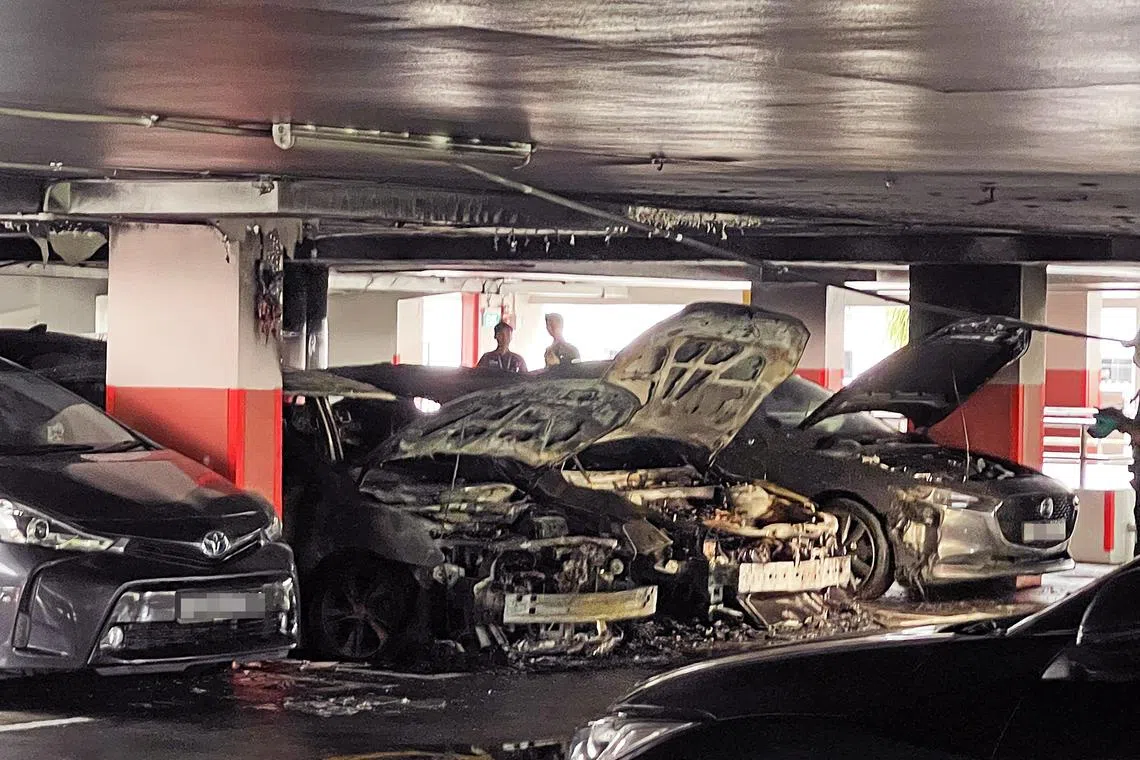Fires at indoor, multi-storey carparks more than double in last 5 years; no EVs involved
Sign up now: Get ST's newsletters delivered to your inbox

In January, a fire broke out at a multi-storey carpark in Ang Mo Kio and damaged several cars.
PHOTO: SHIN MIN DAILY NEWS
Follow topic:
SINGAPORE – The number of fires at indoor and multi-storey carparks has more than doubled over the last five years, although none of them involved electric vehicles (EVs).
Responding to a question raised by Mr Melvin Yong (Radin Mas) in Parliament, Minister of State for Home Affairs and National Development Muhammad Faishal Ibrahim said on April 8 that the number of such fire incidents has “remained low” over the years, with 14 in 2020, 12 in 2021, 18 in 2022, 27 in 2023 and 36 in 2024.
Associate Professor Faishal added that these incidents were caused by vehicular issues such as the overheating of engine compartments, electrical faults in carpark infrastructure, as well as the careless disposal of lighted materials.
He noted that the increase in fire incidents in 2024 was largely driven by a rise in vehicular fires.
Mr Yong had asked for a yearly breakdown of the number of fires at indoor and multi-storey carparks in the last five years, the common causes of these fires and the measures to contain the fires quickly.
In January, a fire broke out at a multi-storey carpark in Ang Mo Kio
On the measures, Prof Faishal said all carparks are required to be designed with fire safety provisions.
For instance, he said, indoor carparks are equipped with fire-resistant walls and doors to prevent fires from spreading to other parts of the building.
Carparks also need to be well-ventilated naturally or by mechanical means to dissipate any heat or smoke, noted Prof Faishal.
Sprinklers are required for enclosed basement carparks, he added, and all these fire safety measures are regularly maintained and inspected.
In a follow-up question to Prof Faishal, Mr Yong brought up concerns about the potential risk of EV-related fires due to the rising adoption of EVs in Singapore.
He added that EV fires are relatively harder to put out, compared to fires caused by combustion engine vehicles.
Mr Yong asked if there are guidelines on where EV chargers should be installed at carparks to better facilitate firefighting operations, such as installing them only on the ground level, for example.
Prof Faishal said safety guidelines are already in place for EV chargers.
Noting that the installation of EV chargers is not restricted to any particular floor, he said they have to comply with safety distances and must be within a certain distance of a power cut-off switch.
He added that EV fires will take a longer time to be extinguished because such fires are self-generating. Thermal runaway may occur, he noted, producing heat and oxygen that continue to fuel the fire.
Thermal runaway refers to the state in which an EV battery overheats uncontrollably.
Prof Faishal added that an EV fire could take several hours to be extinguished, compared with fires involving internal combustion engine vehicles that take around 10 to 15 minutes to be put out.
He noted that it is key for the public to keep a lookout for such fire incidents, and to use fire extinguishers that are available at HDB blocks.
“But be mindful that there are certain aspects where you just need to call 995 immediately,” added Prof Faishal.


